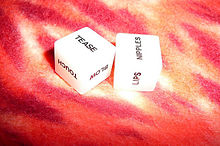created 2025-04-02, & modified, =this.modified
rel: Game Sound by Karen Collins
aleatoric - ety. according to the die

A Musikalisches Würfelspiel (German for “musical dice game”) was a system for using dice to randomly generate music from precomposed options. These games were quite popular throughout Western Europe in the 18th century. Several different games were devised, some that did not require dice, but merely choosing a random number.
Der allezeit fertige Menuetten- und Polonaisencomponist - the ever-ready minuet composer.
According to Lawrence Zbikowski, “In truth, chance played little part in the success of the music produced by such games. Instead, what was required of the compilers…(was) a little knowledge about how to put the game together and an understanding of the formal design of waltzes, etc.”
The way these games work may be understood in analogy to sentence construction.
1 The cow ran past the field.
2 The pig walked through the yard.
3 The sheep ran into the marsh.
You roll one die for each word and selects the word from the appropriate column according to the number, so 1 2 3 1 2 3 means the pig ran past the marsh
The first known musical dice game was that of Johann Philip Kirnberger (1721–83), Der allezeit fertige Polonoisenund Menuetten componist (Berlin, 1757). The ‘‘Minuet Composer,’’ as it was known in English, allowed for the composition of either a polonaise (through the rearrangement of one six-bar sequence and one eight-bar sequence), or a minuet and trio (both eight bars). There were two tables of numbers provided: one for the polonaises, one for the minuets. Then, twenty-nine pages of music were to be cut and placed onto a deck of cards, with one bar of music (consisting of one soprano line and one bass line for the polonaise and minuet, or two soprano lines and one bass for the trio). The ‘‘composer’’ then threw two dice, consulting the table to determine which card to use next. Notes Stephen Hedges (1978, p. 181), ‘‘Obviously, Kirnberger had written a polonaise and a minuet and trio, composed ten variants, segmented the pieces into individual bars and camouflaged the whole thing with a table of numbers. The minuet would always be in D major with a fixed harmonic progression and the trio would always be in D minor. The melody was the real variable. There were 116 possible melodies for the first period of the polonaise, 118 possibilities for the second period, and 1132 possibilities for the minuet and trio.’’
Thus, through sheer mathematics, the composer was ensured an ‘‘original’’ work.
Thought
I… I had a point here, but I lost it.
Thinking of this feature ”Thus, through sheer mathematics, the composer was ensured an ‘‘original’’ work.”
This idea of an original work. If you give every human a task, they will produce a unique creation (regardless of skill). Only a subset of these will be “advanced” or deemed culturally correct solutions.
For example if I had all humans, and said make me a website that contains three boxes that hold videos. Most every human is capable of making manipulating a mouse, and typing up some HTML (though some would fail this task). There might be some output convergence (because of the rigid syntax and simplicity of the tasks) but the process would be different. I would say, the majority of humans would fail this task, but their failures will be unique, even in minor ways. Only a small group would be useful for us (for a relatively simple task).
But what would be wrong about their attempts? It would all be original, an attempt. If it is a true attempt, it’s not precisely chaos. It points towards something, and is molded by that thought.
For the computer, combinatorially creates something new, just like every shuffling of a deck of cards creates a cosmically unique derangement (likewise, something with a GUID collision, you simply don’t have to worry generally.) It can develop identity, and uniqueness by this derangement. It doesn’t need to directly copy, it can drift.
What I mean, is that the answers produced, by humanity and each individual is unique.
When we see a product of an LLM in this task, or AI it is like saying “this page exists, somewhere in a different form” This is the manner it is used. Because someone came up with it (in these attempts (failed, succeeded) and mismatches of elements, it is there.
Anyway…
Sex Dice
Sex dice is a dice game intended to heighten the sexual atmosphere and promote foreplay. Instead of numbers, each face on the dice contains the name of a body part; the body part that faces up when the die is rolled must then be given sexual attention.
